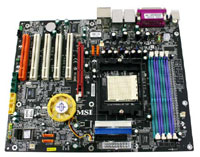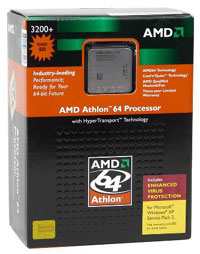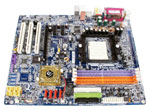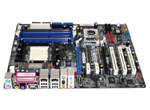Buyer's Guide - Mid-Range, January 2005
by Jarred Walton on January 21, 2005 11:09 AM EST- Posted in
- Guides
AMD Motherboard and CPU Recommendations
We've already covered the basic dilemma with the AMD platform right now: to PCIe or not to PCIe, that is the question. You hopefully know yourself well enough to have made a decision on whether you want to be an early adopter or if you want to trail behind the bleeding edge and take a conservative approach. Our recommendations, incidentally, are made in light of what is actually available right now. We look at several vendor sites as well as our own RealTime Pricing Engine to find out what is currently in stock. That means there are exactly three PCIe boards from which to choose, and two of them are really in the high-end performance market (the SLI boards).
 |
 |
| Click images to enlarge. | |
AMD Platform Recommendation
Motherboard: MSI K8N Neo2 Platinum (NF3 250 Ultra)Price: $139 Shipped
Processor: Athlon 64 3200+ 90nm (Retail)
Price: $215 Shipped
On the conservative approach, we continue to stick with the AGP platform and the nForce3 250 Ultra chipset. The MSI K8N Neo2 Platinum [RTPE: MSI K8N Neo2 Platinum] has worked very well in our testing, and we have several systems using it that are running without any problems. Tweaking and overclocking options are very good if it's something that you're interested in, and you get known reliability and performance with a low chance of any unforeseen bugs in your system. If living on the bleeding edge and potentially troubleshooting your new PC on a regular basis is not your idea of a good time, this is still the most sensible platform. Realistically, this will probably be the last time that we actually recommend this platform, as the new nForce4 motherboards - not to mention alternatives using the ATI Express 200 chipsets and perhaps even some VIA PCIe solutions - should reach the point where we can give them a full recommendation by the time we next run our Mid-Range Guide.
For the processor, we opt for the 90nm Athlon 64 3200+ part [RTPE: ADA3200DIK4B]. It offers plenty of power with a reasonable price. Overclockers will also appreciate the added clockspeed headroom and reduced heat of the 90nm parts, but that's a topic for another Guide. A 3500+ would be nice, but the 90nm parts are too expensive while the 130nm 3500+ has a higher power draw. Our tests showed that the power draw of the 90nm parts is significantly lower than the 130nm parts. So, if you're the one actually paying the electricity bills, the 90nm parts will easily save you money over time, relative to the 130nm parts - particularly if you leave your PC running 24/7.
 |
 |
 |
| Click images to enlarge. | ||
AMD Platform Alternative
Motherboard: Gigabyte GA-K8NF-9 (NF4 4X)Price: $146 Shipped
Motherboard: ASUS A8N SLI Deluxe (NF4 SLI)
Price: $197 Shipped
Processor: Athlon 64 3500+ 90nm (Retail)
Price: $324 Shipped
For those who like to live on the edge, PCI Express boards are finally starting to appear at retail. Finding them in stock, unfortunately, can be difficult, and this affects our recommendation. You'll have to wait for a full review, but our "mid-range" suggestion right now is to pick up the Gigabyte GA-K8NF-9. Newegg has listed the Chaintech VNF4/Ultra [RTPE: Chaintech nForce4 Ultra VNF4] for a couple weeks now, but either they're disappearing so fast that they're almost never in stock, or they may not really be available yet. The Chaintech looks to be the potentially better performer, as it includes the Ultra version of the nForce4 chipset instead of the cheaper 4X version. The difference, if you recall, is that the Ultra has an unlocked HyperTransport multiplier that should offer more in the way of overclocking, while the 4X is supposed to be locked at a 4X HyperTransport multiplier (800 MHz) - at least, it's not validated to run at anything other than 4X. If you're not concerned with official validation, the Gigabyte GA-K8NF-9 [RTPE: Gigabyte nForce4 GA-K8NF-9] is readily available from several sources, and it includes some additional features like IEEE1394b.
If you're really serious about shifting to PCI Express boards right now, a better pick would probably be the ASUS A8N SLI Deluxe [RTPE: ASUS nForce4 A8N-SLI Deluxe], which is available for about $200 now from several locations. Gigabyte and MSI also offer SLI boards, but they're less available and even more expensive than the ASUS. We've talked a lot about the benefits of SLI vs. non-SLI, but let's just say that it's the only option that makes a lot of sense to us at this moment in time. If you really want to make the shift to PCI Express, you might as well get an SLI motherboard at the same time. It's a high-end option, of course, but so are all PCIe graphics cards above the 6600GT.
For the processor on our alternative platform, we've upgraded to the Athlon 64 3500+ processor [RTPE: ADA3500DIK4B]. Spending more for the 3800+ will take us well out of the mid-range price segment, as the 3800+ costs nearly twice as much as the 3500+ - even the 3500+ is rather expensive. We use the 90nm 3500+ as opposed to the 130nm version (which is cheaper at present). With the potential SLI video cards sucking down a lot of power, it can't hurt to cut the processor's power consumption.










46 Comments
View All Comments
Rocket321 - Saturday, January 22, 2005 - link
Could someone explain what has changed between the NEC 3520A and 3500A. I checked the Anandtech Fall 16x roundup and it has the 3500A listed as DVD-R 16x.Dranzerk - Saturday, January 22, 2005 - link
Mmm, i bought my 930sb from Newegg about 6 months ago, guess they ran out fast. Oh well. :(N3cr0 - Saturday, January 22, 2005 - link
Well, I think I may go with the system described with the ASUS board but a 3000+ processor to save some cash. As it stands right now, anything is an upgrade from my Celeron 1.2 system. The XFX 6600GT is also available for dramatically less then the Leadtek (40-50$ less) 6600GT, so I'm going to be going with that also.Zebo - Saturday, January 22, 2005 - link
"The Diamond Pro 930sb Mitsubishi monitor is also a excellent CRT choice for 19inch."Too bad no one sells it:(
Zebo - Saturday, January 22, 2005 - link
KILLER CHOICES!!!'Another good mobo is epox 9NDA3J... it's $45 less than MSI..same clocks many say better with new bios. I post at 330 HTT now vs 315 before.. My mem OCs much more too..
JarredWalton - Friday, January 21, 2005 - link
20 - NEC and Mitsubishi "merged" on the monitor segment. The NEC FE991SB is almost the same monitor as the Diamond Pro 930SB. The 930SB did have a few advantages, like a 110 KHz hoizontal scan rate and a slightly higher max resolution, and perhaps a few cosmetic differences.Unfortunately, the 930SB is no longer available online as far as I can tell (and it did cost a bit more). That's why it's no longer in the Guide. If you can find one, it's still a great monitor, although I wouldn't pay much more than $285 for it.
Dranzerk - Friday, January 21, 2005 - link
The Diamond Pro 930sb Mitsubishi monitor is also a excellent CRT choice for 19inch. Very nice monitor, gets great reviews, and cheap to boot.I beleive it used to be Anandtech buyers guide..maybe another type? check it out
JarredWalton - Friday, January 21, 2005 - link
#17 - certainly something to think about, although there are so many possible causes that a lot of people don't tend to list in forums. For example, are they overclocking? What sort of PSU are they running (as a 300GB three platter hard drive inherently uses more power than an 80GB one platter drive)?Most of the posts seem to be related to having RAID issues. I won't even get into the subject of RAID, but having two of those drives running is going to further increase the power demands. What sort of GPU do they have, CPU, etc.? People looking at running two or even three $200 drives are probably putting in other high-end hardware as well, and a 480W PSU - even a quality Antec, Enermax, etc. - may not be able to handle the power demands.
Anyway, the Maxtor is merely listed as an alternative. Plenty of people are using them without any problems, but they're also not using two of them in most instances.
PrinceGaz - Friday, January 21, 2005 - link
Those are a truly excellent set of recommendations for systems in that price-range, Jarred. Compared with your first few guides which I considered to have quite a few poor choices; I read through this guide from start to finish, and without exception either agreed with your choices or would have went with something so close it made no real difference.I'm very close to building an nForce4/A64 box and regularly looking at my options (the only thing I'm waiting for now is the E0 A64 revision), and at some points what you wrote was so close to my own thoughts that I almost felt as if I was reading something I'd written myself!
The only bone I'd pick is with SLI. I'll probably get an SLI board, but not for the SLI capability but because they tend to have more PCIe sockets generally if you run in non-SLI mode and treat the second x16 as a x1. I'll never buy another legacy PCI card, so the two PCI cards I already have are all I'd ever want to put in a new PCIe system, therefore the more PCIe sockets it has the better. The MSI Neo4 SLI board fails miserably in that respect as it has no PCIe slots at all apart from the two x16 slots, so at most you can put a single PCIe x1 card in. I hope MSI gets suitably slated in the forthcoming review because of that.
mad nebraskan - Friday, January 21, 2005 - link
With all due respect, the recommendation of the Maxtor 250GB drive in combination with the MSI Neo2 MB might not be a good one. I helped a friend who had serious issues trying to get a RAID 0+1 to work using this board. We finally gave up and bought Raptors. A quick search of the net found this forum:http://forum.msi.com.tw/thread.php?threadid=63105&...
Now, the problem might be fixed with the latest BIOS, but I don't think it it.
http://forums.pcper.com/showthread.php?t=368404
Just some thoughts from a guy who banged his head against this particular problem too many times.